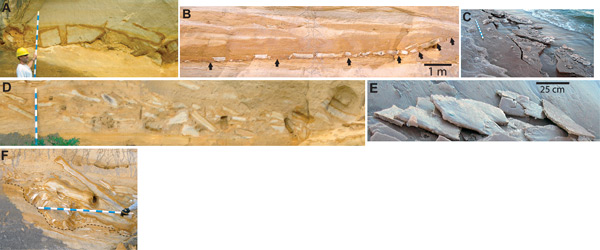
Figure 2.
Large sandstone intraclasts of the Furongian Jordan Formation, Minnesota, USA, and ice-cemented sand clasts on modern, temperate, fresh-water shoreline of Lake Superior. (A) Intraclasts (up to 1.2 m in length) mantle a scour surface and are overlain by beach swash sands (late diagenetic iron oxide staining accentuates intraclast margins). (B–C) Examples of in situ brecciation (intraclast formation) by undercutting and collapse of hard (frozen) swash-zone sand in the Cambrian Jordan Formation (B) and the modern partially frozen, temperate fresh-water shoreline of Lake Superior (C). (D–E) Imbricated intraclasts in the Jordan Formation (D), and imbrication of frozen clasts along modern shoreline (E). (F) Intraclast conglomerate within a steeply channelized scour (dashed line along scour surface). Both the gray area in the lower left and branching streaks in upper part of photo are surface coating of dried, modern mud. Blue and white staff has 10 cm increments. Jordan Formation intraclasts in this and other figures are from section 12 of Runkel (1994), with UTM NAD83, Zone 15 coordinates 595174.486453 (UTME), 4872859.43211 (UTMN). Photographs and descriptions of modern ice-cemented sand are from the shoreline of Lake Superior at Park Point, Duluth area, Minnesota, USA. UTM NAD83, Zone 15 coordinates 572476.465496 (UTME), 5175832.45352 (UTMN).